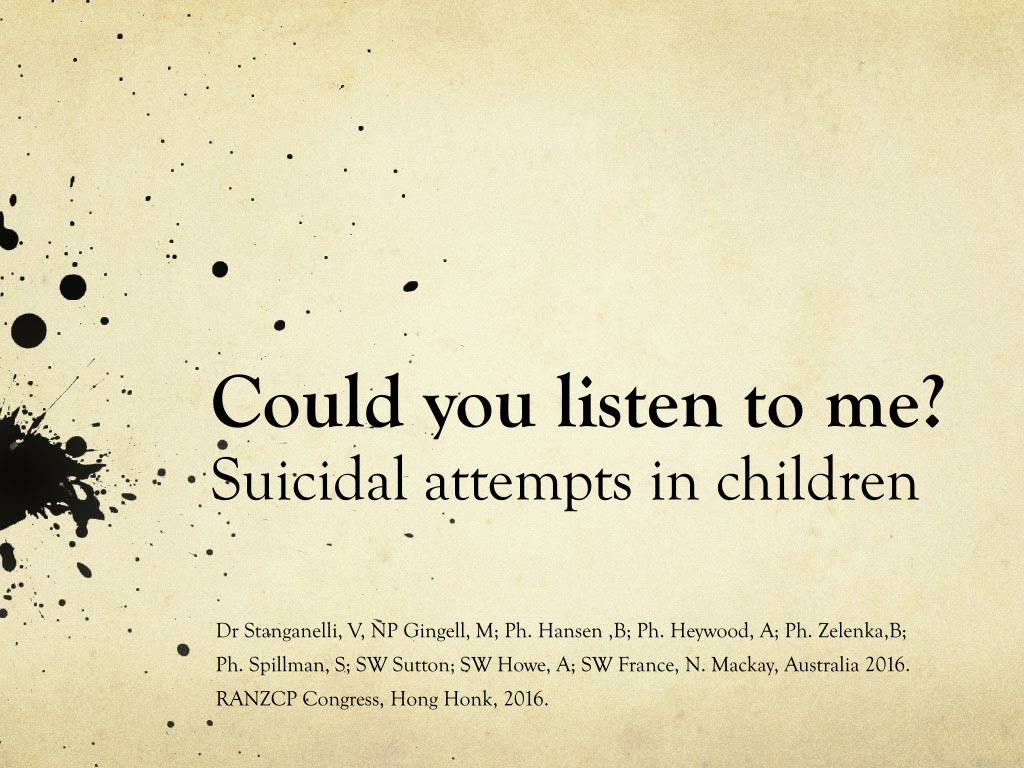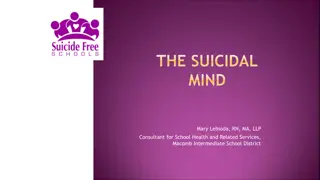Understanding and Addressing Suicidal Attempts in Children
Suicidal attempts in children under 12 are rare but pose significant risks that increase with age. Factors such as bullying, neglect, abuse, and family dynamics play crucial roles. A 10-year analysis reveals insights into admissions for suicidal gestures in pre-pubertal children, highlighting the need for comprehensive assessment and prevention strategies.
Download Presentation

Please find below an Image/Link to download the presentation.
The content on the website is provided AS IS for your information and personal use only. It may not be sold, licensed, or shared on other websites without obtaining consent from the author. Download presentation by click this link. If you encounter any issues during the download, it is possible that the publisher has removed the file from their server.
E N D
Presentation Transcript
Could you listen to me? Suicidal attempts in children Dr Stanganelli, V, NP Gingell, M; Ph. Hansen ,B; Ph. Heywood, A; Ph. Zelenka,B; Ph. Spillman, S; SW Sutton; SW Howe, A; SW France, N. Mackay, Australia 2016. RANZCP Congress, Hong Honk, 2016.
Could you listen to me? Background Suicidal attempts in children under 12 years old are rare Specific data are relatively scarce and inconsistent They are clinically different from youth suicide Engage in concrete operational thinking Rigid cognitive patterns and limited problem solving Pfeffer et al.(1) point out the essential quality of suicidality is the intent to cause self-injury or death, regardless of the cognitive ability to understand finality, lethality or outcomes
Could you listen to me? Pre-pubertal children who have attempted suicide previously may be up to six times more likely to attempt suicide in adolescence, increasing lethality with age.(2) Bullying at home, school and cyber-bullying increase peer pressure, poor performance, loneliness, hopelessness. Family constellations with neglect or abuse are risk factors in children suicidal attempts Losses in childhood, guilt and blame, retaliation, revenge, avoiding punishment, identification with depressed or suicidal parents are frequent causes in these patients
Could you listen to me? Methods Mackay has 21% population aged 0-14 years old We had 31 admissions for suicidal gestures between 0- 12 years old over the past 10 years An interdisciplinary team assessed them with continuity outpatient care Crisis intervention plan and suicidal prevention were successfully implemented
Could you listen to me? 10-year-retrospective analysis: 31 Admissions Female Male 0% 20% 40% 60% 80%
Could you listen to me? 10-year-restrospective analysis Genre/Age/31 Admissions 10 Number of Admissions 8 6 M F 4 2 0 6 7 8 9 10 11 12
Could you listen to me? Method/age N: 31 admission < 12 years old.
Could you listen to me? 10-year-restrospective analysis : MDD(F32.2) Genre/Age/31 Admissions 12 Number of Admissions 10 8 F M 6 4 2 0 6 7 8 9 10 11 12
Could you listen to me? 10-year-restrospective analysis : SUBSTANCE ABUSE(F10/12) Genre/Age/31 Admissions 10 Number of Admissions 8 6 M F 4 2 0 6 7 8 9 10 11 12
Could you listen to me? 10-year-restrospective analysis : ATTACHMENT DISORDER(F94.1) Genre/Age/31 Admissions 8 Number of Admissions 6 F M 4 2 0 6 7 8 9 10 11 12
Could you listen to me? 10-year-restrospective analysis : ADHD/ASD/CD (F90.0/F84.5/F91.0) Genre/Age/31 Admissions 5 Number of Admissions 4 3 M F 2 1 0 6 7 8 9 10 11 12
Could you listen to me? 10-year-restrospective analysis : BULLYING Genre/Age/31 Admissions 10 Number of Admissions 8 6 M F 4 2 0 6 7 8 9 10 11 12
Could you listen to me? 10-year-restrospective analysis : DOMESTIC VIOLENCE Genre/Age/31 Admissions 10 Number of Admissions 8 6 M F 4 2 0 6 7 8 9 10 11 12
Could you listen to me? 10-year-restrospective analysis : PARENTS Genre/Age/31 Admissions MARRIED FEMALE MALE BLENDED DEAD SINGLE 0% 20% 40% 60% 80% 100%
Could you listen to me? 10-year-retrospective analysis: 31 Admissions/Parents SA Schz Anxiety Female Male Suicide Depression 0% 20% 40% 60% 80% 100%
Could you listen to me? Risk factors: More common in boys Depression in girls increase risk Disruptive behaviours/ASD/ADHD in boys increase risk Identification with a depressed/dead/suicidal parent History of bullying at school and DV at home Common method hanging or other under 12 years old 100% Reactive attachment disorder as secondary diagnosis 100% parents with severe mental illnesses
Could you listen to me? Attachment based family therapy (ABFT) has been found to be effective in reducing suicidal ideation in young people( Diamond et al, 2010) The family is the most important developmental and protective factor in childhood The goal is to strengthen families From attachment perspective: children internalize beliefs about self and expectations of others through early attachment relationships as internal working models Attachment theory proposes a life span attachment model
Could you listen to me? ATTACHMENT BASED FAMILY THERAPY It is a brief 16 weeks treatment Aims to re-establish safety, protection and availability It is an experiential context to learn New communication skills Affect regulation skills Interpersonal problem solving skills
Could you listen to me? ATTACHMENT BASED FAMILY THERAPY Relational re frame Alliance with the adolescent Alliance with the parent Reattachment task Promoting competency task (87% recover from the symptoms)(4)
Could you listen to me? CONCLUSIONS Understanding suicidality among children requires listening to their intent and meaning of death, despite of their inability to recognize lethality and outcomes. Family dynamics need to be unfolded and attachment based-family therapy seemed to have favourable results in these cases but in the context of an entire community compromise.
References 1. Pfeffer CR. Suicidal behaviours in children: from the 1980s to the new millennium Review of suicidology, NY: Guilford, 2000 pp. 159-69. 2. Brent et al. Familial transmission of mood disorders: convergence and divergence with transmission of suicidal behaviours. J.Am.Acad.Child Adolesc Psychiatry, 2004;43: 1259-66. 3. Tishler C et al. Suicidal Behaviour in children younger than twelve: A diagnostic challenge for Emergency Department Personnel. Acad.Emerg.Med.200;14:810-818 Doi:10.1197/j.aem.2007.05.014 4. Attachment based Family Therapy . Diamond G, et al. APA video series ISBN 4310925 5. It takes a village: and other lessons children teach us - H. Clinton, Simon &Schuster, January 1996, ISBN; 1-4165-4064-4























